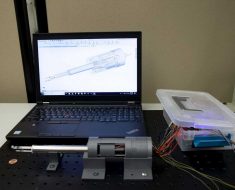An infliximab biosimilar (infliximab-axxq) delivered via subcutaneous injection was superior to intravenous vedolizumab (Entyvio) for induction and maintenance therapy of Crohn’s disease (CD), according to a systematic review and meta-analysis from French researchers.
In contrast, the same research showed no significant differences in efficacy between these agents for people with ulcerative colitis (UC).
The subcutaneous injection formulation of infliximab-axxq, also known as CT-P13 SC, is approved by the European Medicines Agency for both CD and UC (Remsima SC). This formulation is not yet approved by the US Food and Drug Administration.
“It’s kind of a small revolution because now we have access, and in France, we are using a lot of subcutaneous infliximab,” Laurent Peyrin-Biroulet, MD, said during a digital oral presentation at ECCO ’22 Virtual, the European Crohn’s and Colitis Organisation 2022 Congress. He is ECCO president and a gastroenterologist at University Hospital of Nancy in France.
Peyrin-Biroulet and colleagues compared the efficacy and safety of the two agents in major randomized controlled trials looking at moderate-to-severe CD or UC from January 2010 to April 2021.
Subcutaneous infliximab-axxq data came from NCT02883452, an ongoing phase 1 study started in 2016. The vedolizumab data come from GEMINI I, II, and III; VISIBLE 1 and 2; and VARSITY trials.
Key Findings
In CD, induction efficacy was 79% for subcutaneous infliximab-axxq vs a 45% response for vedolizumab, as measured by the Crohn’s Disease Activity Index-70 (CDAI-70).
In addition, the study showed a 62% induction efficacy for subcutaneous infliximab-axxq vs 36% for vedolizumab on the CDAI-100.
The maintenance response on the CDAI-100 was achieved by 64% of the infliximab-axxq patients vs 47% of the vedolizumab patients.
“You can see better efficacy results of subcutaneous infliximab compared to vedolizumab in CD for both induction and maintenance,” Peyrin-Biroulet said, adding that what is seen here is probably what has been observed.
Similar Results for UC
“We know vedolizumab is a good drug in UC, and there was not a difference between UC and CD,” Peyrin-Biroulet said.
There were no significant differences between subcutaneous infliximab-axxq and vedolizumab in terms of clinical response for induction (77% vs 69%, respectively) or clinical response for maintenance (62% vs 63%, respectively).
Similarly, no significant differences emerged in rates of clinical remission or mucosal healing.
Safety So Far
Safety profiles for both agents in both indications were similar over 1 year.
However, Peyrin-Biroulet shared a caveat about that timeline. “It’s a 1-year follow-up, not a 10-year follow-up with 100,000 patients,” he said. “But still, what we see here is a confirmation of what we see in other analyses. There is not a significant [safety] difference between these two drugs.”
The rate of any adverse event in CD was 76% for subcutaneous infliximab-axxq vs 77% for vedolizumab, for example. Rates of any serious adverse event were 9% and 14%, respectively.
In UC studies, the rate of any adverse event was 67% for subcutaneous infliximab-axxq vs 64% for vedolizumab. Rates of serious adverse events were 12% and 11%, respectively.
Rates of discontinuation over 1 year differed between agents. Five percent of subcutaneous infliximab-axxq participants with CD discontinued treatment as because of lack of efficacy compared with 32% with vedolizumab. In UC participants, discontinuation for the same reason was reported for 3% of subcutaneous infliximab-axxq patients vs 15% of vedolizumab.
Although all participants in the subcutaneous infliximab-axxq trial were anti-tumor necrosis factor treatment naive, some in the vedolizumab may have been previously exposed to such therapy, Peyrin-Biroulet said. “Subgroup analyses would be need to further explore that.”
“It’s interesting and a clinically relevant piece of work,” said Mark Samaan, MD, session moderator and consultant gastroenterologist at Guy’s and St. Thomas’ NHS Foundation Trust in London, who was not involved in the study.
“The results are in keeping with what one might expect from IV infliximab administration. In that sense, [it is] reassuring that the two routes of administration appear to perform in a broadly similar manner,” Samaan said.
“So long as adequate exposure is achieved, I wouldn’t have expected route of administration to be a significant determinant of efficacy,” he added.
Peyrin-Biroulet reports receiving personal fees from Galapagos, AbbVie, Janssen, Genetech, Ferring, Tillots, Pharmacosmos, Celltrion, Takeda, Samsung Bioepis, Alma, Sterna, Nestle, Inotrem, Enterome, Allergen, MSD, Roche, Arena, Gilead, Hikma, Amgen, BMS, Vifor, Norgene, Mylan, Lilly, Fresenius Kabi, Opplian Pharma, Sublimity Therapeutics, Applied Molecular Transport, OSE Immunotherapeutics, Enthera, and Theravance. Samaan reports receiving advisory fees from Janssen, Takeda, Sandoz, Samsung Bioepis, Galapagos, and AbbVie and lecture fees from Bristol-Myers Squibb, Janssen, Takeda, MSD, Falk, AbbVie, and Galapagos.
ECCO 2022 Congress: DOP Abstract 73. Presented February 18, 2022.
Damian McNamara is a staff journalist based in Miami. He covers a wide range of medical specialties, including infectious diseases, gastroenterology, and critical care. Follow Damian on Twitter: @MedReporter.
For more news, follow Medscape on Facebook, Twitter, Instagram, YouTube, and LinkedIn
Source: Read Full Article





